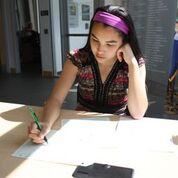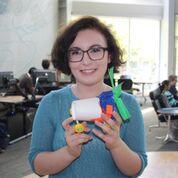Women and Alaska Natives are underrepresented in the STEM fields, but two south peninsula girls are breaking barriers before even leaving high school. They are learning about— science, technology, engineering and mathematics —at University of Alaska Anchorage this summer. The girls are participating in the Alaska Native Science and Engineering Program, or ANSEP, five-week Acceleration Academy.

(Photo Courtesy of ANSEP)
Nikolaevsk School sophomore Chelsea Johnson says ANSEP’s Acceleration Academy is not only fun, it helps her get ahead.
“I think that it is great that I am able to get college credit as a sophomore,” said Johnson.
The 15-year-old is participating in ANSEP’s Acceleration Academy with about 60 other students from around the state. Johnson says the program allows her to explore subjects not available at her school.
“Honestly, it is one of the best opportunities I can see for myself. At Nikolaevsk, there aren’t very many students looking to even go to college, so a program like this really helps me open my eyes. I was introduced to it by my principal and he thought it would be a great idea for me because I was really interested in math and the STEM fields,” said Johnson.
She says the hands-on, collaborative learning approach brings subjects to life.
Johnson got interested in STEM subjects as a seventh-grader when she participated in one of ANSEP’s middle school academies. Now she’s hoping to narrow her interests.
“That’s what I’m hoping ANSEP can do for me, help me figure out what I want to get into exactly. I probably will want to become some kind of engineer and definitely in the STEM fields,” said Johnson.
ANSEP Regional Director Michael Ulroan says the Acceleration Academy sets students on the path toward STEM careers, since they take classes for both high school and university credit.
ANSEP started in 1995 as a scholarship program for university students and has evolved into much more — with programs for students starting at sixth grade and continuing on through high school, undergraduate and graduate degree programs up to the doctorate level.
Ulroan, Cup’ik originally from Chevak, a small community in the Yukon-Kuskokwim Delta of Southwest Alaska, is an alumni of the program. He studied civil engineering and now works for ANSEP while simultaneously pursuing a master’s degree in engineering management.
One of the most important aspects of the program, he says, are the STEM labs, where students work in groups and engage in hands-on activities focused on real-life challenges that professionals might find in the field.
“So for example, students will be participating in a water treatment STEM lab where students will learn the chemistry and the engineering about how water systems treat and filtrate water for our rural villages in Alaska,” said Ulroan.
The activities are designed around teamwork, says Ulroan, and geared toward building positive connections between students from across the state.
ANSEP’s objective is to effect systemic change in the hiring patterns of Alaska Natives in science and engineering by placing students on a career path to leadership.

(Photo Courtesy of ANSEP)
Johnson — the sophomore from Nikolaevsk —is Alaska Native, Yup’ik but ANSEP is open to all students, including Homer High School senior Eryn Gillam.
The 16-year-old has been participating in ANSEP programs since middle school and says she keeps coming back because she can’t get the classes she needs to pursue the college studies she’s interested in.
So far this year, Gillam has completed a motorcar lab, a chemistry lab where she made soap, and she is currently working on a geology lab focused on solving coastal erosion problems in Alaska. She says the program has made her sure that she wants a career in a STEM field.
“I’m either interested in going into biomedical engineering or becoming an educator and doing work similar to what people at ANSEP do,” said Gillam.
Besides getting to take classes that wouldn’t be available to her at Homer High, Gillam says she enjoys connecting with other students.
“One of the other things I like about ANSEP is the community aspect of it. It’s really amazing to come up here and be surrounded by a bunch of other kids with similar interests to me, because in Homer, although there are kids interested in STEM and stuff, sometimes it’s hard to find kids who you connect with in the same way in terms of interest,” said Gillam.
Johnson and Gillam are in their third week of the Acceleration Academy
Daysha Eaton is a contributor with the Alaska Public Radio Network.
Daysha Eaton holds a B.A. from Evergreen State College, and a M.A. from the University of Southern California. Daysha got her start in radio at Seattle public radio stations, KPLU and KUOW. Before coming to KBBI, she was the News Director at KYUK in Bethel. She has also worked as the Southcentral Reporter for KSKA in Anchorage.
Daysha's work has appeared on NPR's "Morning Edition" and "All Things Considered", PRI's "The World" and "National Native News". She's happy to take assignments, and to get news tips, which are best sent via email.
Daysha became a journalist because she believes in the power of storytelling. Stories connect us and they help us make sense of our world. They shed light on injustice and they comfort us in troubled times. She got into public broadcasting because it seems to fulfill the intention of the 4th Estate and to most effectively apply the freedom of the press granted to us through the Constitution. She feels that public radio has a special way of moving people emotionally through sound, taking them to remote places, introducing them to people they would not otherwise meet and compelling them to think about issues they might ordinarily overlook.




